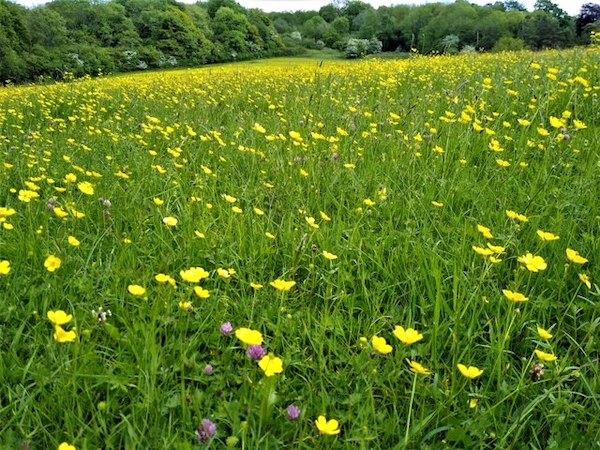
Leader: Marion Rayner
On a warm and sunny spring afternoon seven of us gathered on Bathwick Hill to enter the gloriously colourful National Trust meadows that are part of the Bath Skyline Walk. We made our way across a meadow awash with Buttercups towards an area of Hawthorn bushes in full ‘May’ blossom. This is a known site for the Corky-Fruited Water-Dropwort (Oenanthe pimpinelloides) that grows in a damp area and was just forming flower heads. We stopped to investigate the many species of grass also in flower here.
The path led us down through Richen’s Orchard with its Apple and Walnut trees before rising up over another meadow and down a steep slope towards Smallcombe Lane. At the bridge over the stream we noticed some Common Toothwort (Lathraea squamaria) under the streambank trees.
We crossed over the lane and headed uphill again past the nuttery field, taking note of the Hazel, Almond and Walnut trees as well as a large Mulberry tree planted by the Widcombe Community Association. On the path Alan spotted a Small Copper butterfly alighting on Dandelions.
At the next field we noted the Pocket Plum galls caused by the fungus Taphrina pruni on many of the sloe fruits looking like swollen tongues, and took time to admire the diverse flora in the fields adjoining Widcombe Hill. As well as Yellow Rattle (Rhinanthus minor), Cowslip (Primula veris) and Red Clover (Trifolium pratense) there were three species of Buttercup: Meadow (Ranunculus acris) Bulbous (Ranunculus bulbosus) and Creeping (Ranunculus repens).There were several sightings of Orange Tip butterflies as well as Speckled Wood and Holly Blue.
We ventured into Smallcombe Wood to find Coralroot (Cardamine bulbifera) which was present in large patches throughout the wood. Although it had finished flowering the dark bulbils in the leaf axils of the tall stalks were very noticeable. We braved the muddy path to make our way down steep slopes of Ramsons (Allium ursinum) to the stream, This originates as a spring in the top of the wood and seeps down the slope in several channels. Here we found some examples of petrifying tufa which had formed limestone nodules that could be snapped open to reveal a small twig or seed buried inside.
We followed the path down into Smallcombe Cemetery and noted some increase in spring flowers around the open cemetery area compared to earlier years before stopping by one of the old chapels to collect a sample of a tiny moss with capsules encrusting a rock. Microscopic examination later identified this as Slender Stubble-moss (Gyroweisia tenuis)- a new record for Smallcombe Cemetery.
As time was pressing and there were concerns about parking restrictions we all went our separate ways in Smallcombe Lane after a pleasant afternoon of blossom and flowers.
Marion Rayner

Recent Comments